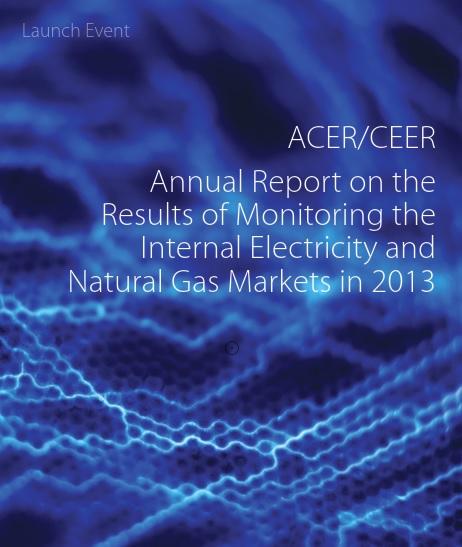22.10.2014
ACER Market Monitoring Report 2014 - Why is the decrease in wholesale energy prices not reflected in retail prices?

Despite a general decrease in wholesale energy prices, gas and electricity retail prices continued to grow in 2013, although at a slower pace than in previous years. On average, the electricity bill for households increased by 4.4% while gas prices rose by 2.7%. The latest Market Monitoring Report presented today in Brussels by the EU Agency for the Cooperation of Energy Regulators (ACER) and the Council of European Energy Regulators (CEER) identifies a vicious circle in many Member States wherein a lack of competition results in low switching rates, which is sometimes used to justify regulated tariffs which, in turn, can hamper competition.
In order to break that trend, Alberto Pototschnig ACER Director advocated “the removal of barriers to entry into retail markets by fully implementing the Third Energy Legislative Package, adopting the network codes and phasing out regulated prices for non-vulnerable customers as soon as possible”.
Wholesale market integration improving, but more flexibility required
At the wholesale level, both for gas and electricity, market integration continues to progress. In 2013, the efficiency level in the use of electricity interconnectors continued to increase, due to market coupling, reaching a level of 77%. However, this has not always resulted in an increase in price convergence. This is mainly due to the challenge posed by the penetration of renewables. Going forward, a larger share of variable and non-programmable renewable-based generation in the electricity system will require more flexible-response resources, including from demand response.
Regulators foresee a transition by 2025 to a low-carbon society, where flexible and responsive markets will change the way consumers engage with energy (and which will require enhanced regard for consumers’ protection and rights). Pointing to the concrete actions outlined by regulators in the Bridge to 2025 proposals to better engage small consumers in the market, Lord Mogg, Chair of ACER’s Board of Regulators and CEER President highlighted “the need for an appropriate framework to include demand-response in the market”.
In the gas sector, the main challenge identified is the need to promote the liquidity of gas trading and ensure that all unused capacity, whether or not strategically acquired, can be easily returned to the market so that other shippers can use it if short-term trading opportunities arise.
What is hampering retail competition?
The lack of product and price differentiation provides few incentives for household consumers to switch supplier. This lack of switching and weak retail competition is often used to justify maintaining regulated prices, which in itself may hamper competition (especially if regulated prices are set below costs levels). But, there has been some progress. In 2013, the number of Member States with regulated prices has fallen, for example in electricity from 18 to 15, compared to the previous year. Also hampering retail competition is the fact that the energy component on which retailers can compete is relatively small.
Despite this effect, opportunities for consumers to get a better deal by switching are available, yet switching rates remain low in most Member States. The report notes that in some cases, it could be due to loyalty or risk aversion, but ACER and CEER also make a call for raising awareness of switching opportunities through, among other initiatives, the development of transparent and reliable online price comparison tools as well as transparent energy prices.
If you wish to find out more:
ACER Press Release
ACER Citizens’ Summary
ACER Market monitoring Report 2014


